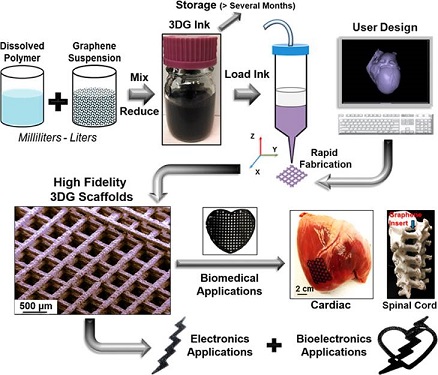Exploiting graphene's exceptional electronic, mechanical, and thermal properties for practical devices requires fabrication techniques that allow the direct manipulation of graphene on micro- and macroscopic scales. Finding the ideal technique to achieve the desired graphene patterning remains a major challenge.
One manufacturing route that researchers have been exploring with increased intensity is inkjet printing where liquid-phase graphene dispersions are used to print conductive thin films. Inkjet printing, however, doesn't help much when trying to build three-dimensional (3D) graphene structures.
This is where 3D-printing comes in. Applying 3D printing concepts to nanotechnology could bring similar advantages to nanofabrication – speed, less waste, economic viability – than it is expected to bring to manufacturing technologies.
These 3D printing techniques are reaching a stage where desired products and structures can be made independent of the complexity of their shapes – even bioprinting tissue and entire organs is now in the realm of the possible.
"From a 3D printing perspective, graphene has been previously incorporated into 3D printed materials, but most of these constructs comprise no greater than about 20 volume % of the total solid of the composite, resulting in electrical properties that are significantly less than what we describe in our recent work," says Ramille N. Shah, Assistant Professor, Materials Science and Engineering and Assistant Professor, Surgery (Transplant Division), Simpson Querrey Institute for BioNanotechnology at Northwestern University.
In new work, Shah and her team, who worked with Mark Hersam's group at Northwestern, show that high volume fraction graphene composite constructs can be formed from an easily extrudable liquid ink into multi-centimeter scaled objects.
The results have been published in a paper in the April 10, 2015 online edition of ACS Nano ("Three-Dimensional Printing of High-Content Graphene Scaffolds for Electronic and Biomedical Applications").

"Our resulting 3D printed constructs contains majority graphene while maintaining structural integrity and handability, which is enabled by the particular biocompatible elastomer binder – PLG – that we chose in combination with the solvent system," explains Shah.
She notes that a significant motivating factor behind this work was the need for more innovative biomaterials for nervous tissue regeneration, and also biomaterials that are translatable – i.e. scalable and not so expensive to produce.
Theses novel 3D printable graphene inks are relatively easy to produce in a scalable fashion, can be rapidly fabricated into an infinite variety of forms (including patient specific implants), and are also surgically friendly (can be trimmed to size and sutured to surrounding tissue).
It was known previously that graphene and conductive materials could influence cell behavior, particularly those related to neurogenic stem cell lines. Many previous studies, however, used neural stem cells, which are already predisposed to become neuron-like cells but are difficult to translate clinically.
A highly interesting result for stem cell researchers is the demonstration of neurogenic differentiation of adult mesenchymal stem cells without added biological factors – such as nerve growth factor – or electrical stimulation (unlike neural stem cells, adult mesenchymal stem cells are a more translatable cell source since they can be easily obtained from patients).
"In our experiments, we have shown the ability of 3DG scaffolds to induce neurogenic differentiation of adult mesenchymal stem cells without the need for any other neurogenic growth factors or external stimuli," Shah points out. "This is a major finding that supports the use of materials themselves for inducing specific cellular responses that can be leveraged for tissue engineering and regenerative medicine applications."
The researchers' results suggest that the unique physical, electrical, and biological properties of 3DG could open the door to addressing a variety of medical problems requiring the regeneration of damaged, degenerated, or otherwise non-functional electrogenic tissues such as nerves, bone, or skeletal and cardiac muscle.
Beyond regenerative medicine applications, there are a number of other potential medical applications including using 3DG in implantable biosensors and/or electrical devices. Outside of medicine, there is potential for 3DG to be used for biodegradable electronics or sensors in consumer products.
This work is an excellent example of how 3D printing can aid in developing entirely new kinds of functional material systems, with unique, and highly advantageous properties, such as those exhibited by 3DG. Particular challenges to realize this include the creation of 3D printable functional material inks that are also scalable and translatable. Another challenge is the ability to 3D print multiple types of materials to create functioning devices. Last but not least, innovations in 3D printers themselves are still needed to be able to easily scale and multi-material print at a commercial manufacturing level.
Source: Nanowerk
